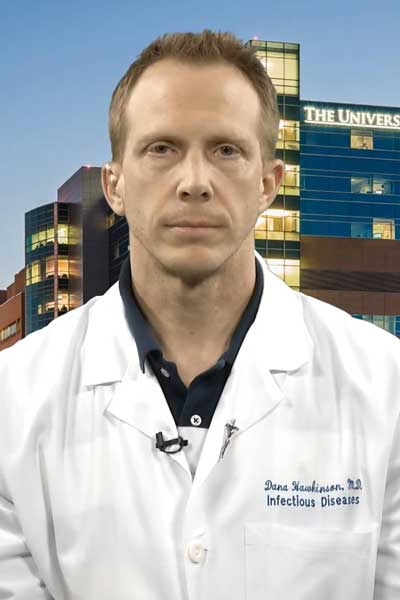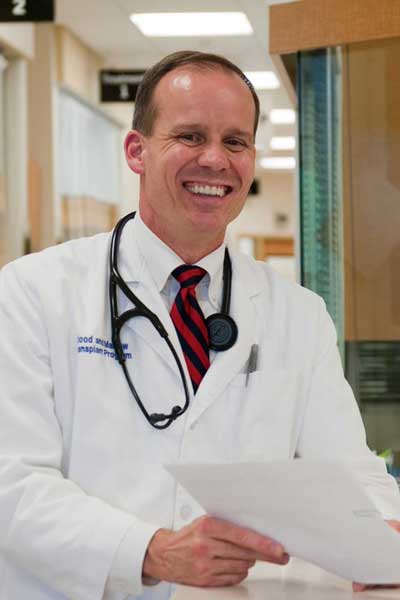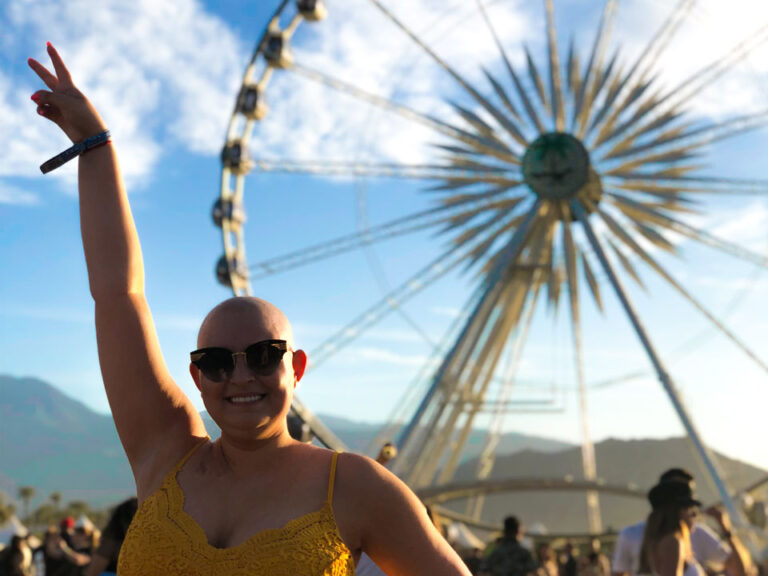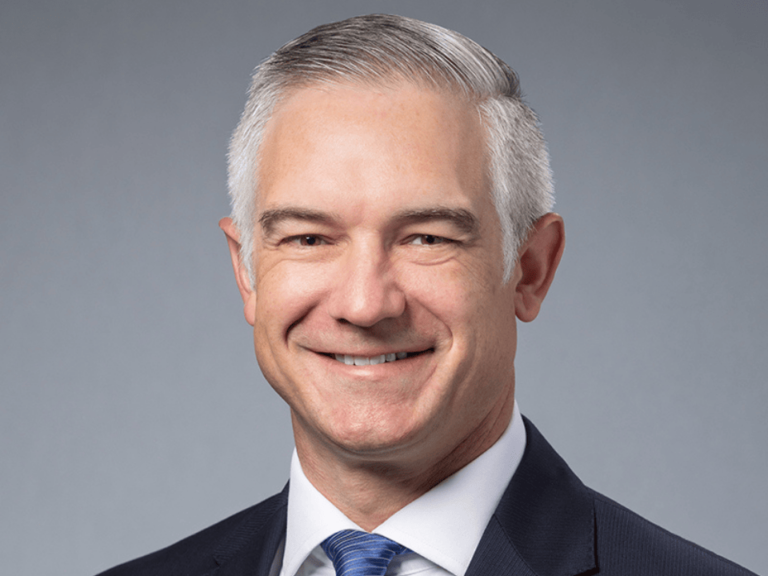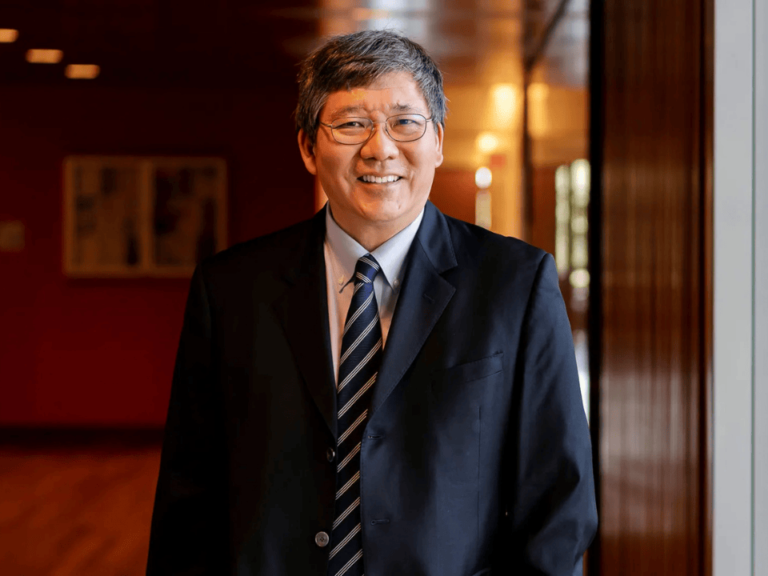The following is a transcript from a weekly Facebook Live program, where Roy Jensen, director of The University of Kansas Cancer Center and Kansas Masonic Cancer Research Institute, interviews cancer researchers, clinicians, and patients.
On March 11, Jensen, who is also William R. Jewell Distinguished Kansas Masonic Professor and professor of pathology and laboratory medicine, anatomy and cell biology, cancer biology and molecular biosciences, focused on COVID-19.
At this writing there are four cases of COVID-19 in Kansas. Three are at home quarantine, and one was treated at The University of Kansas Health System.
A video of the conversation can be found here.
Jensen spoke with Dana Hawkinson and Joseph McGuirk:
Roy Jensen:Dr. Hawkinson, could you first tell us about the current state of the virus, not only here locally, but nationally. What are the risks? What do we know, what we don’t know and how are things changing?
Dana Hawkinson: Yes. As a quick overview of novel Coronavirus or SARS- CoV-2, obviously most people know this was a virus was discovered originally in December 2019, in China. There were multiple infections, there continued to be widespread infection and now it’s reached around the globe.
Currently, there is no local spread. In the United States there are some communities that have had person-to-person and community spread, but this number and these infections are changing daily. So a lot of what we’re saying is at this point in time or at the current state, this virus is similar to the SARS virus, which was originally discovered in 2002.
It has about 70 to 80% homology with that virus, that means it’s similar. In most people, in 80% of people, it causes very mild illness in which you don’t need hospitalization
It doesn’t seem to affect children or patients under the age of 19, in fact, I think it’s about 2% of cases or less from the published reports.
But in general if we’re talking about other patient populations such as anybody with underlying co-morbid illnesses like heart failure, diabetes, underlying lung disease, and of course any neoplastic or oncologic disease, certainly they can develop and progress to severe disease in a higher probability than other patients who don’t have those underlying diseases.
So, Dr. McGuirk, in regard to cancer patients, which ones would you say are at greatest risk for major complications for COVID-19? And I suspect that many of the patients that you care for fall into that category.
Joseph McGuirk: Yes, very much so. And so many of our therapies compromise the immune system and particularly in the blood cancers where it’s the immune system itself and parts of it that are cancerous. And so, we suppress the immune system on purpose. And that sets our patients up for risk for infections, including this organism as well.
Many of our patients are of advanced age, and that in and of itself appears to be a risk factor for the acquisition and becoming quite ill in a threatening way with this virus. And patients who have received in general beyond those particular populations, bone marrow transplant, blood cancer patients, but even solid tumor patients who are actively receiving or relatively recently have received chemotherapy. Those are vulnerable populations of patients in particular with this virus.
So, Dr. Hawkinson, what is your general advice for cancer patients in regard to exposure to this virus and how to prevent that?
DH: First of all, I want to say I echo everything that Dr. McGuirk has said. It’s all absolutely true. As far as protecting yourself, again, individual vigilance has been most important and that includes appropriate hand-washing.
Certainly in patients who are older or have an underlying cancer diagnoses or on chemotherapy, trying to social distance, keeping yourself, not necessarily isolated or quarantined, but trying to avoid areas where there are mass groups or mass gatherings. This includes anything from possible sports events to bus stations, to airports, sometimes even grocery shopping or churches.
It’s important to understand those risks, and, in doing so, also, because we are touching surfaces all the time—door handles, railings—and this disease is really caused by droplets, but also fomites which are inanimate objects, such as high touch surfaces. We touch those surfaces and then we’re touching our eyes, our nose or mouth. That is the main ways that we contract this disease.
So, staying vigilant in hand hygiene, trying to avoid putting your hands in your eyes, nose, mouth, social distancing as much as possible—those are really the main ways that we can stay healthy, especially if we do have underlying malignancy or chemotherapy or otherwise immunocompromised state.
At this point in time locally, it doesn’t seem like there’s community spread, but things can change rapidly in the next week, in the next two weeks, three weeks. And so, it’s important to stay vigilant on the news, keeping up with the accurate websites such as the CDC and the Kansas Department of Health, and local health departments for their news and advisories on travel and other things to do to protect yourself.
So, that advice sounds very similar to what we’re giving to the general public. I’m sure that one of the specific questions that cancer patient has is around their appointments and coming in to see the physicians. Is there any advice around that situation that either one of you have say in the first case, where someone is just concerned about being exposed to the virus, and in the second case where they may be exhibiting symptoms that cause them to be concerned?
DH: I’ll just start by saying as an individual you are probably more at risk of complications or problems by not seeing your physician. So if you think there are issues, absolutely call the clinic, absolutely call the physician, and try to get some guidance at that point, because there are other things out there as well.
Locally there’s not a lot of community spread. The disease rate is not high for COVID-19, but there are certainly other things that are still important and can cause severe illness.
So many of our therapies compromise the immune system and particularly in the blood cancers where it’s the immune system itself and parts of it that are cancerous. And so, we suppress the immune system on purpose. And that sets our patients up for risk for infections, including this organism as well.
Joseph McGuirk
Influenza activity around here is still very high. We diagnose multiple cases of influenza every day here at the health system, both in the inpatient setting and outpatient setting. So, individually, I would say continue to be vigilant, talk with your provider, get good guidance, and by all means, if it’s safe and you’ve talked with your provider, please come into your clinic visit because missing a clinic visit could be even worse. And I’ll let Dr. McGuirk speak on the global issues with the—
JM: I completely concur. That’s exactly right, and that is the straightforward, sensible advice to contact the treating team, the healthcare team.
There are, as Dr. Hawkinson just mentioned, the majority of our patients who have respiratory viral symptoms, and it’s common that this time of year we’re seeing these patients every day in our cancer center and our bone marrow transplant clinic, are influenza, respiratory syncytial virus, parainfluenza, and some of these viruses can be very aggressive in our population of patients and we have treatments, effective treatments, for some of them, not all of them.
And so, it’s always critically important that we know about that and we can guide our patients in terms of coming in, taking special precautions for example, and coming to clinic to minimize exposure to others regardless of what type of virus it is, and then isolating those patients as soon as they come in, so that we can investigate what’s going on with them.
The audience wants to know: Can you have the flu and Coronavirus at the same time? Dr. Hawkinson?
DH: Initial reports and anecdotal reports and the data would suggest that with other infections, other viral infections you certainly can have co-infections and sometimes those percentages of people that have co-infections can be fairly high. With COVID-19 and other infections, such as influenza, it doesn’t seem like there is a high rate of co-infection. So, at this point in time what we are telling patients is if you have tested positive for influenza, you’re positive for influenza. There’s at this point in time, no need to further test for COVID-19.
What about traveling, or attending sporting events, or concerts or large crowds? What approach should cancer patients in particular take in regard to those types of events?
JM: We’re currently—and I would be interested to hear what Dr. Hawkinson says about this approach.
We’re currently being very prudent and very conservative in our cancer center and recommending that our patients, particularly those who are most vulnerable, patients in active treatment or relatively recent treatment, all of our patients with blood cancers, that they not travel, unless it’s absolutely essential, and then that we help coordinate that effort for them, that they stay away from large crowds, that they even consider, during this particular time, avoiding church, going to the grocery store in the off-hours.
But, as Dr. Hawkinson pointed out earlier, when they go to that grocery store, being mindful of what they’re touching, keeping their hands away from their face, taking Purell, for example, with them and washing their hands frequently. So, some practical measures, with regard to even our staff, our physicians.
We have protocols for bringing patients in in a controlled manner, getting the patients to the correct isolation or precaution rooms, and then thereby keeping our other patients safe as well as our healthcare providers.
Dana Hawkinson
As you know, Dr. Jensen, we’ve canceled and rescheduled a number of really important meetings that people worked on all year long, because if our healthcare providers become ill, first and foremost, they won’t be able to care for the patients that we need to be caring for.
But, secondly, they may have an asymptomatic phase, and they can spread that virus, potentially.
I think we’re pulling out all the stops in our institution to mitigate a rapid expansion of this virus in our community. And part of that traveling, self-imposed traveling restrictions, not just on our patients and their families, but also on our faculty, and not having large groups of people get together. It has been a very important issue over the last couple of weeks.
So, Dr. Hawkinson, could you talk a little bit about the steps that have been taken to ensure that [for] any patient that would come here to be treated for coronavirus at our institution has the infrastructure and the support that they need, but also what we’ve done to protect our staff and our other patients from becoming infected with the virus.
DH: We have had a multidisciplinary approach at the health system for many years now to dealing with emerging infectious diseases. So, we have had multiple service lines available to help to formulate plans.
This includes emergency management, the emergency department, the supply chain, making sure we have enough supplies and resources to be used. We have protocols for bringing patients in in a controlled manner, getting the patients to the correct isolation or precaution rooms, and then thereby keeping our other patients safe as well as our healthcare providers.
We take that with utmost importance and we feel that we have worked on these processes and procedures for the past few years. We tried to smooth them out as much as possible. We’ve been hoping for the best and preparing for the worst and we continue to streamline these processes, and this includes not only the hospital but also the clinics including the Westwood Cancer Clinic as well.
So, it sounds like we have a question from our audience: “What should you do if you think you might be infected?”
DH: The first thing to do is probably call your primary care provider or your treating team, especially if you are one of the cancer center patients. Call the treating team first. Get some information from them.
At this point in time, the testing is certainly done through the state, and so any testing would be performed through the state and we would get the testing performed should you need it.
There are still screening criteria which we need to abide by, but I think the first thing to do is call the treating team, get information from them, and then they are able to relay it to the infection prevention team, and we will determine: should we be testing for COVID-19 or is it another illness?
And, as Dr. McGuirk pointed out, there are certainly other respiratory viruses still going on. There are still other illnesses out there. And so, I think getting that information from your treating team, from your treating physician is probably the first step.
It looks like we have an additional question: Where should you go for more information about the coronavirus?
DH: The best places to go are accurate and informative websites. The best is probably CDC, so cdc.gov. Another important one is probably your state health department, whether it’s Kansas Department of Health Environment, or Missouri State Health Department. I would say start there, because we all know that there’s plenty of information out there on the internet, but those are probably the most reliable resources for COVID-19.
I think one of the most encouraging things that I’ve heard about the COVID pandemic is that there’s been one report out of China [and] one report out of Seattle, that infection control protocols within healthcare systems work against this virus. And the two reports that I’m referring to, and while this is early, there’s been no transmission to health care workers that have taken the appropriate precautions, either in China or in Seattle. And so, I think that that’s an extraordinarily positive development.
DH: It certainly reinforces the fact that simple measures help constrain this virus. Simple measures such as hand washing, proper equipment, the gloves, the gowns, the droplet precautions. Again, it’s important for us to keep our healthcare workers safe so they can treat ill patients and keep other patients safe. So I would agree 100% with what you said.
It sounds like we have another question. The audience wants to know, what are your considerations for the rural community regarding coronavirus?
DH: I think at this point there is not a large, or any community spread around this area. The rural community still seems to be safe. Obviously, being rural, you are not interacting with many other people in general. So, I think it’s just a matter of keeping an eye on your own health and continuing to monitor for any community spread or activity of the virus at this point in time. And just monitoring.
What about the prospects for a vaccine against COVID?
DH: I know people are working on it. Labs are working on a vaccination as well as therapeutics. There are no treatments for this virus. It’s probably at least one to two years away for a vaccine. For other therapies, those are currently in trials, either anecdotally or through government trials as well, but right now, there’s really nothing else to use other than supportive care.
This story is part of The Cancer Letter’s ongoing coverage of COVID-19’s impact on oncology. A full list of our coverage, as well as the latest meeting cancellations, is available here.


